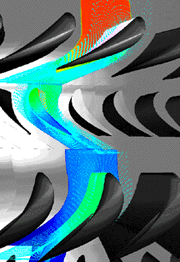 Go to the Applications Software Table of Contents
Go to the Applications Software Table of Contents
Objective: To develop 3-D turbine blade row analysis that enables the integration of component simulations for engine system analysis. Codes shall be ported to different computer architectures and communication techniques developed to reduce analysis cycle time.
Approach: A turbomachinery code, ADPAC, developed by Allison under NASA contract serves as the backbone of this task. The code is modified and applied in four areas: (1) Parallelization of ADPAC under various computer architectures, particularly LeRC supported Parallel Processing Testbed which include clustering of workstations and IBM SP/2. (2) Code validation on turbomachinery components of E3 engine. (3) Improvement of numerical algorithm to achieve high convergence rate and stability. (4) Adaptation of the code for intercomponent analysis requirements of NPSS.
Accomplishments: (1) ADPAC has been modified for parallel computation. The newly developed parallel ADPAC links library routines in PVM for clustering workstations running UNIX, and in MPL for IBM SP/2. It has been applied to simulation the flow in high-pressure turbine of EEE engine. With 16 workstations computing in parallel, the performance is approximately equal to Cray YMP. (2) A generalized subroutine for the circumferential-averaged boundary condition in ADPAC has been implemented. The subroutine has been validated for different grid orientation in order to test various portions of the subroutine. This subroutine is currently available for parallel ADPAC. (3) The parallel ADPAC has been applied to simulate the flow through EEE 2-stage high-pressure turbine rig test. The result looks reasonable. The exit Mach number as calculated is near 0.5, compared with 0.42 designed exit Mach number. The velocity vector at the exit is nearly parallel to the wheel axis, an ideal design condition.
Significance: Accurate and efficient flow analysis is vital to the success of NPSS. The flow codes implemented in NPSS require rigorous validation and extensive tailoring for NPSS. In terms of efficiency, parallel computation has been proven promising in increasing computer power with limited resources.
Status/Plans: ADPAC has been parallelized and applied to the high-pressure turbine flow in E3 engine with success. Its efficiency and off-design prediction capability will be improved by implementing upwind/LU algorithm. Validation of ADPAC will continue for the low-pressure turbine flow in EEE engine.
Point of Contact:
 Go to the Applications Software Table of Contents
Go to the Applications Software Table of Contents